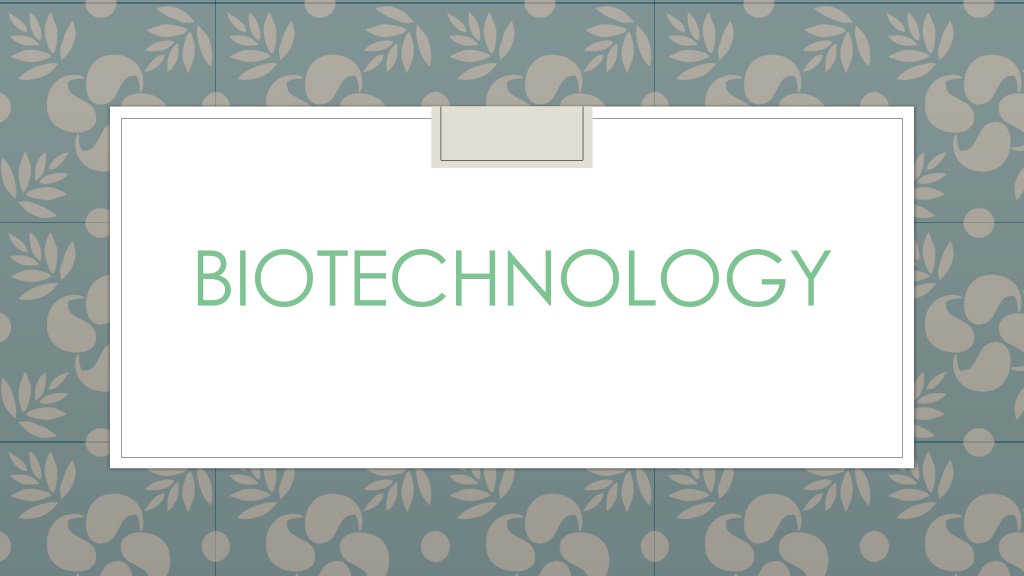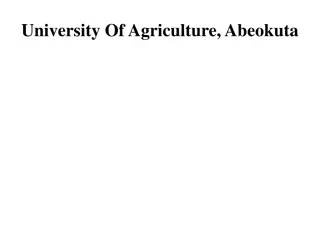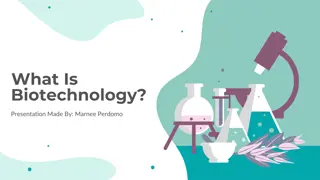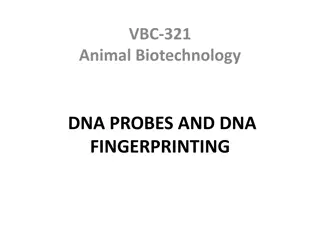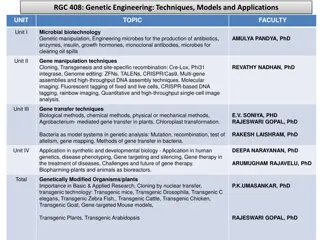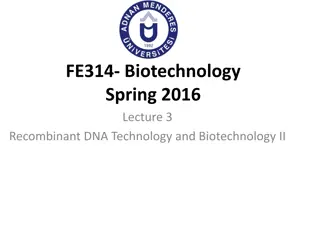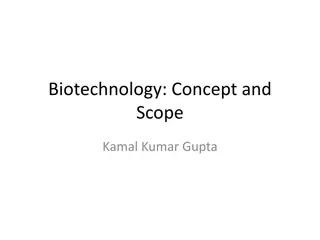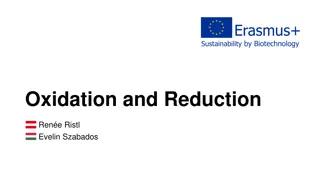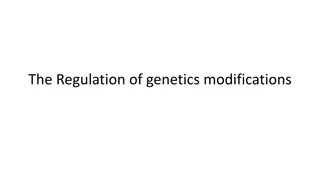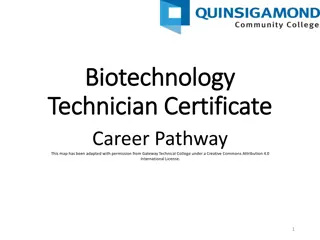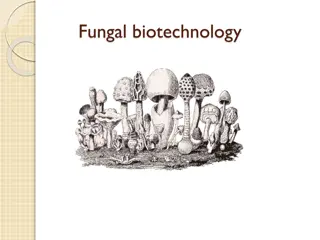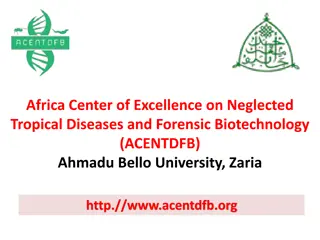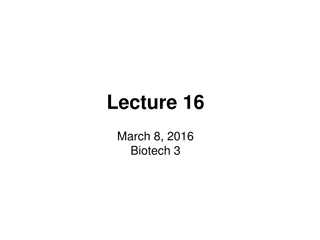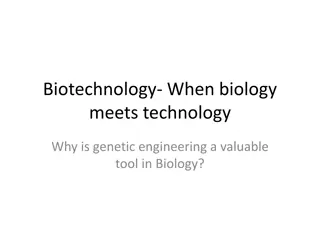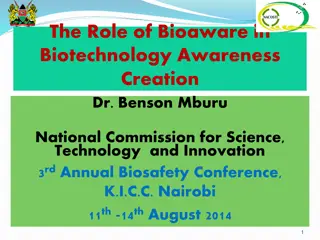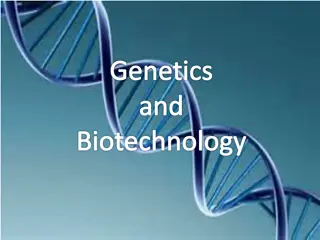Understanding Biotechnology: Techniques, Definitions, and Applications
Biotechnology involves the use of living organisms or their components to develop products in various fields like Industry, Agriculture, Medicine, and Food Processing. It integrates biochemistry, microbiology, and engineering sciences for industrial applications, including genetic engineering to create new traits in crops and animals. The principles of biotechnology, such as genetic engineering, play a crucial role in the production of biotechnological products like antibiotics and vaccines.
Download Presentation

Please find below an Image/Link to download the presentation.
The content on the website is provided AS IS for your information and personal use only. It may not be sold, licensed, or shared on other websites without obtaining consent from the author. Download presentation by click this link. If you encounter any issues during the download, it is possible that the publisher has removed the file from their server.
E N D
Presentation Transcript
Biotechnology Technique of using live organisms, their cellular components or enzyme to produce products and processes useful to us in Industry, Agriculture, Medicine and food processing.
Definition of biotechnology Biotechnology is the integrated use of biochemistry , microbiology ,and engineering sciences in order to achieve technological (industrial) application of the capabilities of microorganisms ,cultured tissues cells and parts thereof by European Federation of Biotechnology . OR Biotechnology is the application of biological organism ,system or processes to manufacturing and service industries .
Biotechnology may be studied in two phases:
Traditional Biotechnology It includes the process that are based on the natural capabilities of microorganisms. Curd, vinegar, ghee, wine and beer and other alcoholic beverages, idli, dosa, paneer and some other food have been produced using traditional biotechnology.
Modern biotechnology New and useful traits in crop varieties and animal breeds are created with the help of genetic engineering. For example, in vitro fertilization leading to production of test tube baby .
Principles of Biotechnology Genetic Engineering The technique of altering the chemistry of genetic material (DNA and RNA) and introduce it into host organisms to change its phenotype is known as genetic, engineering. Used in Manufacturing of biotechnological products like antibiotics, vaccines, enzymes, etc.
A piece of DNA, introduced into a foreign organism would not be able to multiply itself in the organism. Recombinant DNA But when it gets incorporated into the genetic material of the recipient, it may multiply and be inherited along with the host DNA. The foreign piece of DNA after becoming a part of the chromosome, it possesses the ability to replicate. There is a specific DNA sequence called the origin of replication in a chromosome that is responsible for initiating replication. A piece of DNA, introduced into a foreign organism would not be able to multiply itself in the organism. But when it gets incorporated into the genetic material of the recipient, it may multiply and be inherited along with the host DNA. The foreign piece of DNA after becoming a part of the chromosome, it possesses the ability to replicate. There is a specific DNA sequence called the origin of replication in a chromosome that is responsible for initiating replication.
Recombinant DNA Idea of Artificial Recombinant DNA Molecule emerged from the possibility of linking of gene encoding antibiotic resistance with a native plasmid of Salmonella typhimurium. Stanley Cohen and Herbert Boyer In 1972, isolated the antibiotic resistance gene by cutting out a piece of DNA from a plasmid, which was responsible for giving antibiotic resistance .
RECOMBINANT DNA These plasmid DNA act as vectors to transfer the piece of DNA attached to it just as the female Anopheles mosquito acts as an insect vector to transfer the malarial parasite into human body. In the similar manner a plasmid can be used as vector to carry an alien piece of DNA into the.
RECOMBINANT DNA Thus, an foreign DNA linked with the origin of replication, can replicate and multiply itself in the host organism. It is also called cloning that forms multiple identical copies of any template DNA.
Recombinant DNA Linking of antibiotic resistance gene with the plasmid vector occurs in the presence of the enzyme DNA ligase, which cut of the DNA molecules and joins their ends. Now a combination of circular automatically replicating DNA is created in vitro, that is called recombinant DNA.
RECOMBINANT DNA When this recombinant DNA is transferred into Escherichia coli, a bacterium closely related to Salmonella it replicates in the presence of the new host's DNA polymerase enzyme and make multiple copies. The ability to multiply copies of antibiotic resistance gene in E. coli was termed as cloning of antibiotic resistance gene in E. coli.
GENETICALLY MODIFIED ORGANISM (GMO) There are three basic steps in genetically modifying an organism: Identification of DNA with desirable genes. Introduction of the identified DNA into the host. Maintenance of introduced DNA in the host and transfer of the DNA to its progeny
VECTORS LIGASE TOOLS OF RECOMBINANT DNA RESTRICTIONENZYMES HOST POLYMERASE ENZYME TECHNOLOGY
RESTRICTION ENZYME Molecular Scissors :-Exonucleases Endonucleases Biotechnology Restriction Enzymes These enzymes belongs to a larger class of enzymes called Nucleases. ENDONUCLEASE EXONUCLEASE They make cuts at specific position with IN THE DNA They remove nucleotides from the ends of the DNA.
RESTRICTION ENDONUCLEASE The first restriction endonuclease, Hind II, whose functioning depended on a specific DNA nucleotide sequence. It was found that Hind II always cut DNA molecules at a particular point by recognizing a specific sequence of six base pairs. This specific base pair is known as the recognition sequence for Hind II.
Exonucleases are a broad class of enzymes that cleave off nucleotides one at a time from the 3 or 5 ends of DNA and RNA chains. This activity contrasts with endonucleases, which hydrolyze internal phosphodiester bonds.
NAMING OF RESTRICTION ENDONUCLEASE The convention for naming these enzymes is that the first letter of the name comes from the genes and the second two letters come from the species. E.g. Eco RI comes from Escherichia coli R713. In Eco RI, the letter 'R' is derived from the name of strain. Roman numbers following the names indicate the order in which the enzymes were isolated from that the strain of bacteria
Palindromic sequence Each restriction endonuclease recognizes a palindromic nucleotide sequences in the DNA. specific Palindromes are groups of letters that from the same words when read both forward and backward . "MALAYALAM". The palindrome in DNA is a sequence of base pair s that reads same on eg the two strands. For example, the following sequence reads the same on the two strands in 5 3 direction. This is also true if reads in the 3 5 direction.5 - GAATTC - 3
DNA LIGASE It forms phosphodiester bonds between adjacent nucleotides. Ligase enzyme requires a phosphate group at the 5 carbon of one nucleotide and a hydroxyl group at the 5 carbon of the adjacent nucleotide to from the phosphodiester bond. The enzyme used most often in the Recombinant DNA Technology.
ALKALINE PHOSPHATASE Used for the removal of the phosphate group from the 5 end of a DNA molecule, leaving a Free 5 hydroxyl group . Isolated from bacteria (BAP) or calf intestine(CAP) . Used to prevent unwanted self-ligation.
